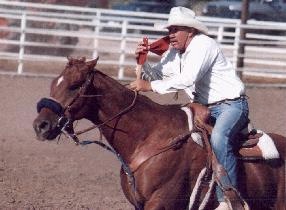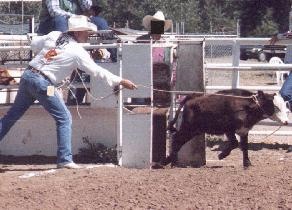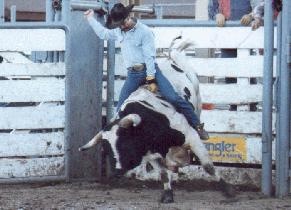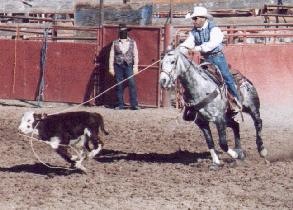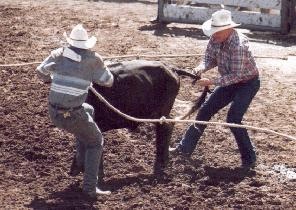feature
A guide to The San Diego Gay Rodeo 2010
Published Thursday, 09-Sep-2010 in issue 1185
This year’s Gay Rodeo promises some very new and exciting additions such as the shuttle system that will run from Mo’s to the rodeo both days, for your safety and drinking pleasure. If you have never attended the rodeo it is a true cultural experience that most of us urbanites would normally not have the chance to attend, let alone be surrounded by our community all weekend. This year’s rodeo will be held at The Lakeside Fair Grounds and the general admission is $10.
This year Family Matters will also provide a place for all the little cowboys and cowgirls. The rodeo gates open at 9:30 am on Saturday and Sunday and close at 5 pm both days. Remember that it gets pretty hot out there so bring plenty of sunscreen and drink lots of water, as beer and heat are never a good combination. Most importantly have fun and support yet another amazing community event.
Shuttles will run both Saturday and Sunday from the host hotel, the Sheraton Mission Valley from 9:00 am with stops at Urban Mo’s in Hillcrest until the rodeo is over.
Rodeo events will include the
following:
Bull Riding
The ultimate event of the rodeo. Bull Riding is an advanced version of Steer Riding, but with one and a half ton more beef to contend with and the added danger that many bulls turn back on the rider and attempt to get even for having their routine disrupted! Guaranteed! Once on the bull and the gate opens, few riders ever leave this event without being slammed to the ground and scurrying for cover, as the Bull Fighter moves in to save the cowboy or cowgirl.
Steer Riding
This is a good beginner’s event, but not as easy as it looks. The rider has a “bull rope” wound around the steer just behind the front legs and then around his or her hand; no knots allowed. This hand hold and the riders legs, locked like scissors on the steer, are all the rider has to count on to stay on top. A rider who is able to spur or move their legs back and forth on the steer’s sides, will receive a higher score.
Chute Dogging
This event is designed to give even the novice a chance to compete in rough stock events. The steer and the contestant both start in the bucking chute and face a 60-second time limit. When the chute gate opens, the contestant must bring the steer out to a 10-foot line in front of the chute, and then attempt to wrestle, or “dog” the steer to the ground. The contestant will turn the steer’s head up and towards the steer’s shoulder, hoping the steer will fall over onto its other shoulder, causing all four feet to point in the same direction as the turned head. If the steer is contrary and falls the other way, it is termed a “dog fall” and the contestant can either attempt to turn the head the same direction or let the steer up and start over.
Calf Roping on Foot
This is the second step in a roper’s career. Most beginner ropers practice on fence posts or other stationary objects and then move in to the arena with a live animal. The contestant stands in the roping box and when the calf is released, attempts to throw the loop over the calf’s head. Once the loop passes over the calf’s head, the contestant must pull up the slack in the rope.
Break-Away Roping
The roper is mounted on horseback with one end of his or her rope tied to the saddle horn by a piece of string. When the calf is released from the chute, the roper will be in hot pursuit with lasso swirling above his or her head. When the loop is thrown, it must pass completely over the calf’s head. As the calf pulls away from the rider and horse, the rope grows taut and will break away from the saddle horn.
Team Roping
Hours of hard work go into the training for this event. This event is loaded with hazards, such as collisions, entanglements and worst of all, possible loss of fingers. The team consists of two ropers and two well-trained horses. One roper is called the “header” and his or her responsibility is to catch the steer by the horns while the teammate, called the “heeler,” has the responsibility of catching the steer’s back legs, or heels. When the header makes the catch, he or she must wind the rope around the saddle horn, called “dallying off,” and turning the steer away from himself causes the steer’s heels to fly in the air for the heeler’s loop to catch. When both ropers have been successful in their tasks, they must turn their horses to face the steer and pull their ropes taut.
Barrel Race
Contestants vie for the fasted time in running a triangular, cloverleaf pattern around three barrels. The horse and rider are allowed a running start and time begins and ends upon crossing a visible starting line. A 5-second penalty is assessed for knocking over a barrel. The pattern can be started either from the left or right, and contestants that go off the prescribed course are disqualified.
Pole Bending
In this event, horse and rider compete for fastest time working a linear pattern through six equally spaced poles. The poles must be at least 6 feet in height and spaced 21 feet apart. A running start is allowed and a 5-second penalty will be assessed for knocking a pole down, and disqualification will take place if the team goes off course.
Flag Race
A triangular pattern similar to that of the barrel race is used, with the substitution of a pole in place of barrel number three. The two other barrels will have a bucket that is 3/4 full of rabbit pellets placed on top of it, and a flag in one of these buckets. The rider may choose to run to the right or left and as they pass the first barrel, they pick up the flag, race past the pole, back to the second barrel, and attempt to place the flag in the second bucket. If the rider knocks over the first bucket or the pole, a 5-second penalty will be assessed. If the rider does not pick up the flag or misses the second bucket, no time will be given. If the second bucket or barrel is knocked over, the rider is disqualified. Looks easy, but try this at 30 plus miles per hour!
Steer Decorating
This event requires a two-person team. One member stands ten feet from the chute gate holding the end of a 25 foot rope, which is looped around the steer’s horns. The other team member stands 40 feet from the chute and has a 24-inch long ribbon. When the chute gate opens, the team must bring the steer out and across the ten-foot line. One team member tries to tie the ribbon on the steer’s tail while the other team member tries to remove the rope from the steer’s horns. When the ribbon is on the tail and the loop is off the horns, the ribbon-tier must tag the timer.
Wild Drag Race
The Wild Drag Race is an audience favorite all across the IGRA rodeo circuit. Even though the competition is serious and the payoffs sizable, a large number of competitors also believe this to be a very entertaining event for the audience. The drag costumes come from “Goodwill” stores, second-hand stores and many from raiding mom’s closet. A team is made up of one male, one female, one “drag” (either male or female), and one wild steer. The steer, with a halter and a 25-foot lead rope, is in a bucking chute at the beginning of the event. The cowgirl holds the rope and the cowboy and drag stand 40 feet from the chute. When the chute gate opens, the team tries to direct (or harass) the steer toward the finish line, which is 70 feet from the chute. They must get the steer across the finish line, mount the “drag,” and then ride back across the finish line. The “drag” must be mounted on the steer before the steer starts back across the finish line and must stay on the steer until all four feet of the steer have crossed back across the finish line. Sounds easy, but the “drag” may get bucked off several times before the event is ever completed!
Goat Dressing
This two-person event was created specially for gay rodeo. The team stands 50 feet from the point where the goat is tethered. One of the team members has a pair of jockey-style underwear worn over their forearms. When the whistle sounds, the team runs to the goat. The team member without the underwear picks up the goat’s rear hooves, grabs the underwear from around the other member’s arms, and pulls it up the legs of the goat. Both team members must then race back to the start/finish line and cross the finish line to stop the time. The underwear must stay over the goat’s tail bone until the timer is tagged by both members.
|
|
Copyright © 2003-2025 Uptown Publications

